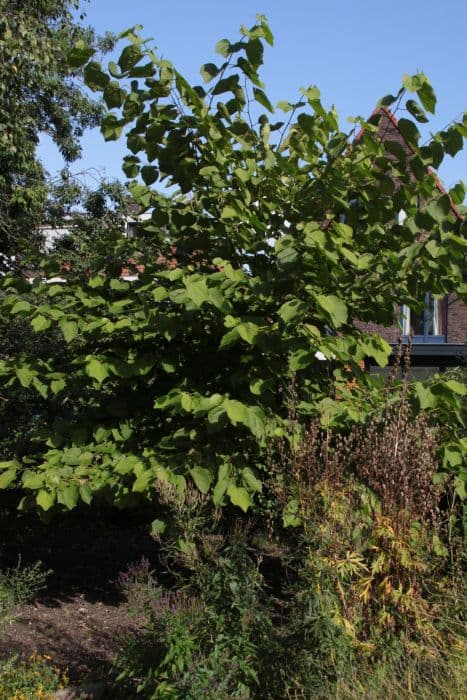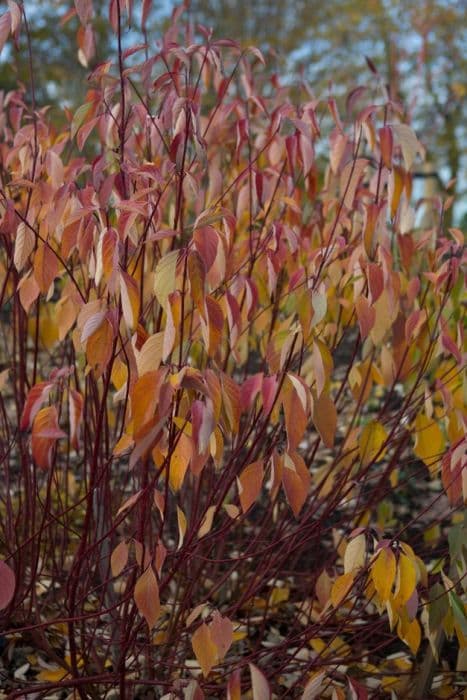Kousa 'Madame Butterfly' Cornus kousa 'Madame Butterfly'











ABOUT
'Madame Butterfly' is a small tree to about 7m with pointed, dark green leaves turning red and purple in autumn. In early summer, tight clusters of small, greenish flowers are surrounded by large, creamy-white bracts with dark pink tips that turn upwards to resemble butterflies. Edible, deep pink, strawberry-like fruit follow
About this plant
 Names
NamesFamily
Cornaceae.
Synonyms
Kousa Dogwood, Korean Dogwood, Japanese Dogwood, Chinese Dogwood.
Common names
Cornus kousa 'Madame Butterfly'.
 Characteristics
CharacteristicsLife cycle
Perennials
Foliage type
Deciduous
Color of leaves
Green
Flower color
White
Height
15 feet (4.57 meters)
Spread
15 feet (4.57 meters)
Plant type
Shrub
Hardiness zones
5
Native area
Asia
Benefits
 General Benefits
General Benefits- Ornamental Value: Cornus kousa 'Madame Butterfly' is highly valued for its decorative appeal with abundant, large, star-shaped flowers that bloom in late spring to early summer.
- Four-Season Interest: This plant offers interest throughout all seasons with flowers in spring, fruits in summer, colorful foliage in fall, and exfoliating bark in winter.
- Wildlife Attraction: The fruits are edible and attract a variety of birds and wildlife, making it an excellent choice for creating a wildlife-friendly garden.
- Drought Tolerance: Once established, it is relatively drought-tolerant, making it suitable for gardens with limited water availability.
- Pest Resistance: It is known to be resistant to many of the pests and diseases that commonly affect other dogwood species.
- Shade Tolerance: It can tolerate partial shade, allowing flexibility in garden design and placement.
- Low Maintenance: Requires minimal pruning and care once established, making it ideal for gardeners of all skill levels.
- Urban Tolerant: This cultivar can adapt to urban conditions, including pollution and compacted soils, which makes it a good choice for city landscapes.
 Medical Properties
Medical PropertiesThis plant is not used for medical purposes.
 Air-purifying Qualities
Air-purifying QualitiesThis plant is not specifically known for air purifying qualities.
 Other Uses
Other Uses- Cornus kousa 'Madame Butterfly', commonly known as Kousa Dogwood, can be utilized in bonsai cultivation due to its attractive form and foliage.
- The bark of Kousa Dogwood can be used for creating artistic textured patterns in crafts, such as in the production of cast paper goods.
- The wood of Kousa Dogwood is hard and can be carved into small, intricate objects like jewelry pieces or decorative ornaments.
- The leaves of the Kousa Dogwood can be pressed and used in botanical art or herbarium collections for educational purposes.
- Dried branches of Kousa Dogwood can be used in floral arrangements to add a unique structural element.
- The fruits, which are edible, can be made into exotic wine with a unique flavor if harvested at the right time and properly fermented.
- Kousa Dogwood fruit puree can serve as a flavorful ingredient for gourmet ice cream or sorbet.
- The textured leaves and branches can serve as natural printing materials for eco-printing techniques on fabric or paper.
- Dried Kousa Dogwood leaves can be used in the crafting of eco-friendly confetti for events and celebrations.
- The Kousa Dogwood's spreading canopy provides valuable shade for moss and fern gardens, creating an ideal microclimate for these shade-loving plants.
Interesting Facts
 Feng Shui
Feng ShuiThe Kousa dogwood is not used in Feng Shui practice.
 Zodiac Sign Compitability
Zodiac Sign CompitabilityThe Kousa dogwood is not used in astrology practice.
 Plant Symbolism
Plant Symbolism- Resilience and Endurance: The Kousa dogwood, known for its ability to withstand harsh conditions and diseases, symbolizes an individual's strength to endure difficulties and bounce back.
- Purity and Innocence: The white bracts of the Kousa dogwood are reminiscent of the white color's association with purity, making it a symbol of innocence and cleanliness.
- Christian Faith: In Christian symbolism, the dogwood's four-petaled flowers are said to represent the cross, and thus it is often associated with faith and the story of Jesus's crucifixion.
- Rebirth and Renewal: Blooming in late spring, the dogwood's appearance signifies the end of winter and the rejuvenation of life, symbolizing the idea of rebirth and new beginnings.
- Love and Affection: With its delicate flowers and appearance, the Kousa dogwood can be a token of love and affection, symbolizing the tender and heartfelt emotions one person may hold for another.
 Water
WaterKousa dogwood trees, including the 'Madame Butterfly' variety, should be watered deeply once a week during the first growing season to help establish a strong root system. After the first year, watering can be reduced to every couple of weeks, depending on the climate and weather conditions. Generally, provide about 1-2 inches of water, or approximately 1-1.5 gallons per square foot every week during the growing season. In periods of drought or extreme heat, increase the frequency of watering to prevent stress. Overwatering can lead to root rot, so ensure the soil is well-drained and not soggy.
 Light
LightThe Kousa dogwood 'Madame Butterfly' prefers a spot with partial shade to full sun. It thrives best in conditions where it can receive morning sunlight and afternoon shade, especially in regions with hot summers. However, it is capable of adapting to full sun exposure, provided it has adequate moisture.
 Temperature
TemperatureKousa dogwood 'Madame Butterfly' performs well in a range of temperatures, though it prefers a moderate climate. The plant is hardy and can tolerate minimum winter temperatures down to about -10 to 20 degrees Fahrenheit. Optimal growth occurs in temperatures between 60 to 75 degrees Fahrenheit. It is important to protect the tree from extreme cold and frost, especially when it's young.
 Pruning
PruningKousa dogwood 'Madame Butterfly' requires pruning to maintain shape and remove any dead or diseased branches. The best time to prune is in late winter or early spring before new growth starts. Pruning should be done sparingly, focusing on keeping the tree's natural form and removing only necessary branches. Periodically thin out the crown to allow light and air movement to the inner parts of the tree.
 Cleaning
CleaningAs needed
 Soil
SoilKousa Dogwood 'Madame Butterfly' thrives in well-draining, loamy soil rich in organic matter with a pH of 5.5 to 7.0. A mix of two parts loam, one part sand or perlite, and one part compost or peat provides an optimal growing medium.
 Repotting
RepottingKousa Dogwood 'Madame Butterfly' does not commonly require frequent repotting and can be repotted every 2-3 years, or when the plant shows signs of being root-bound.
 Humidity & Misting
Humidity & MistingKousa Dogwood 'Madame Butterfly' prefers moderate humidity levels; while adaptable, ensuring consistent humidity without allowing conditions to become too arid or excessively damp is beneficial.
 Suitable locations
Suitable locationsIndoor
Provide bright, indirect light and ensure pot has good drainage.
Outdoor
Plant in partial shade, mulch, water deeply, protect from strong winds.
Hardiness zone
5-8 USDA
 Life cycle
Life cycleCornus kousa 'Madame Butterfly', commonly known as Kousa Dogwood, begins its life cycle when seeds are dispersed by animals or gravity. Upon finding a favorable spot in the soil, the seeds germinate in spring, given adequate moisture and temperature conditions. Seedlings emerge and establish a root system, developing into young saplings with characteristic opposite, simple leaves. As the sapling matures over the years, it forms a distinctive vase-shaped structure with layered branches and starts to produce the variegated white to pink bracts in late spring that visually signal the reproductive stage. The true flowers within the bracts are pollinated by insects, leading to the production of berry-like fruits that attract birds, thereby enabling seed dispersal. Over time, the Kousa Dogwood can reach up to 25 feet in height, going through yearly cycles of growth, flowering, fruiting, and dormancy in winter until it reaches its natural end of life, which can span several decades.
 Propogation
PropogationPropogation time
Spring-Early Summer
The Cornus kousa 'Madame Butterfly', commonly known as the Kousa Dogwood, is typically propagated through softwood cuttings. This method is most successful when cuttings are taken in late spring or early summer when the new growth is still tender and green, yet has begun to harden slightly. To propagate by cuttings, one should select healthy shoots and cut sections approximately 4 to 6 inches (10 to 15 centimeters) long, making sure each cutting has a few leaves. The bottom end of the cutting is then dipped in rooting hormone to facilitate root development and planted in a moist potting mix. It's important to maintain high humidity and steady warmth around the cuttings to encourage rooting, which can be aided by covering the pot with a plastic bag or placing it in a propagator. With proper care, the cuttings will root in a few weeks, after which they can be gradually acclimatized to outdoor conditions.









